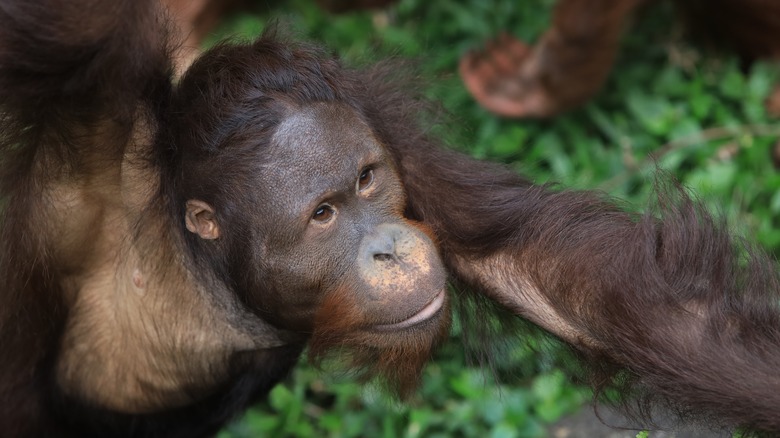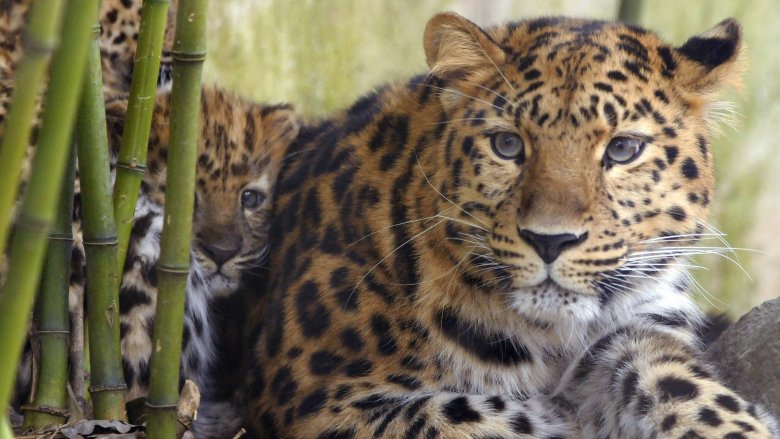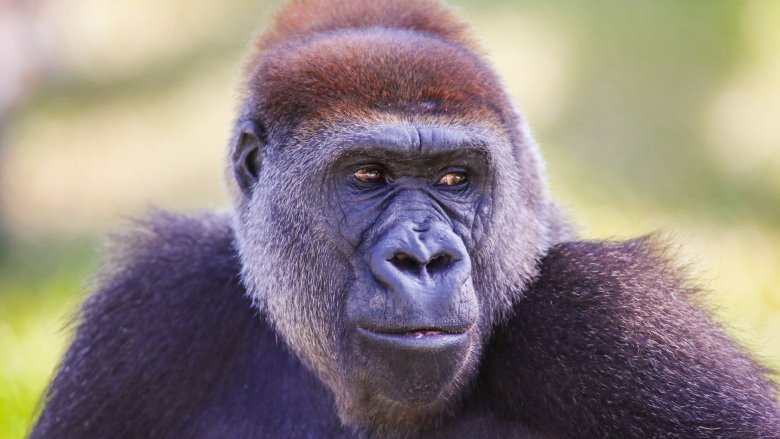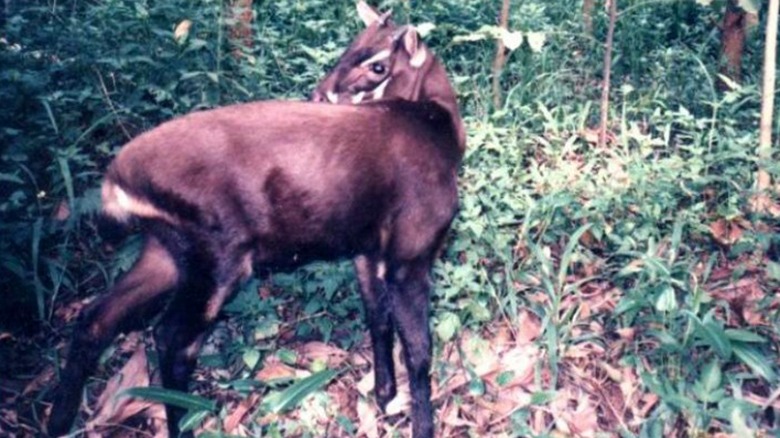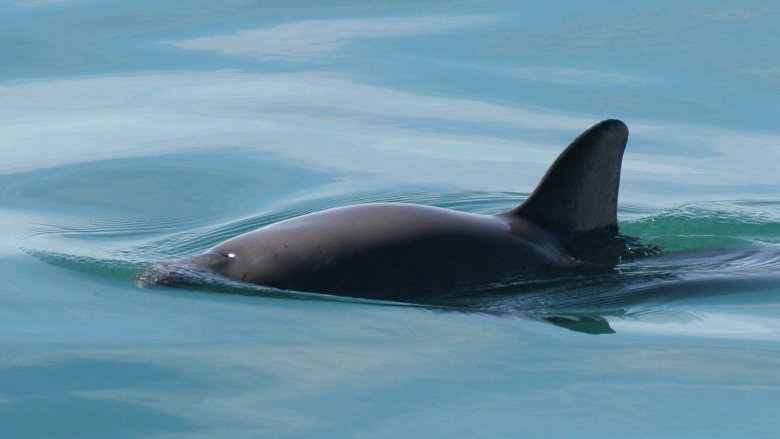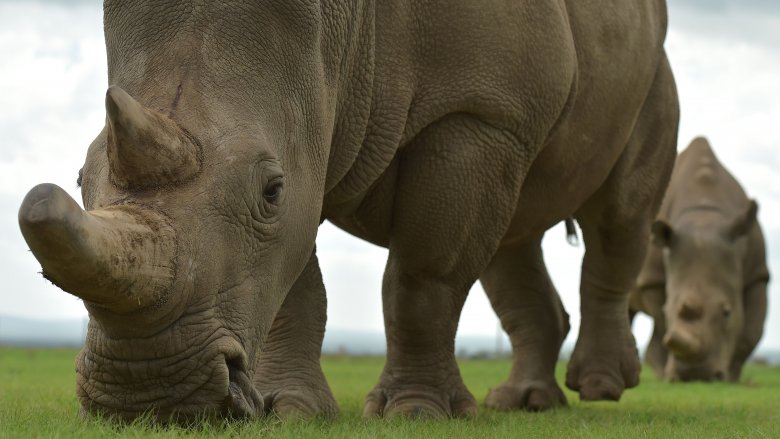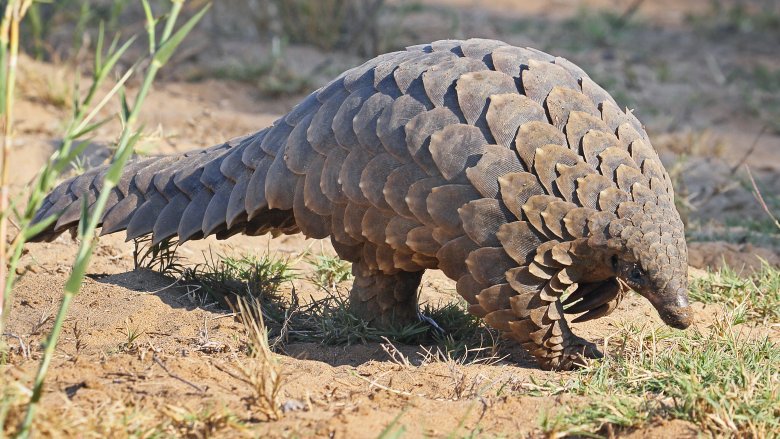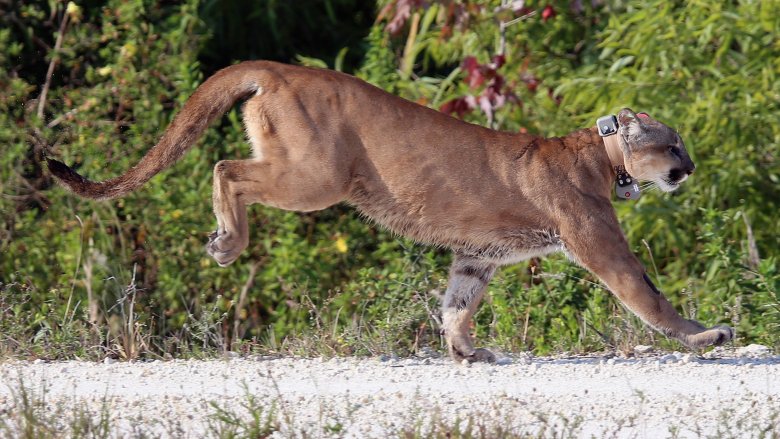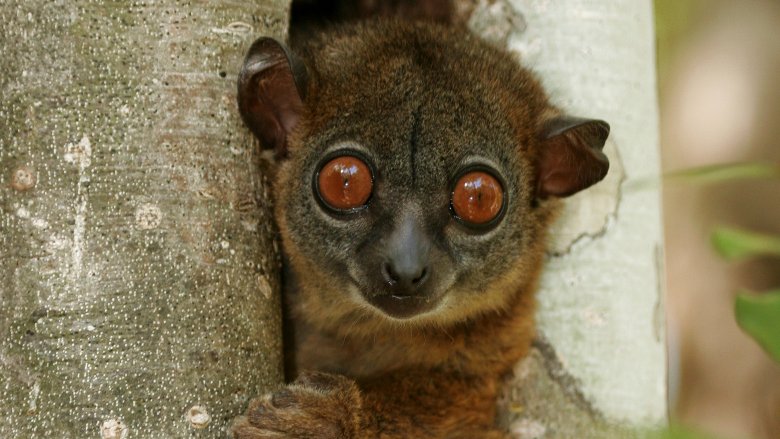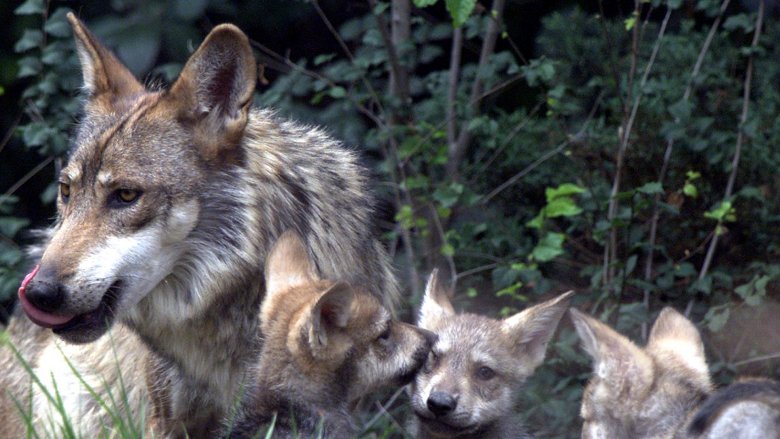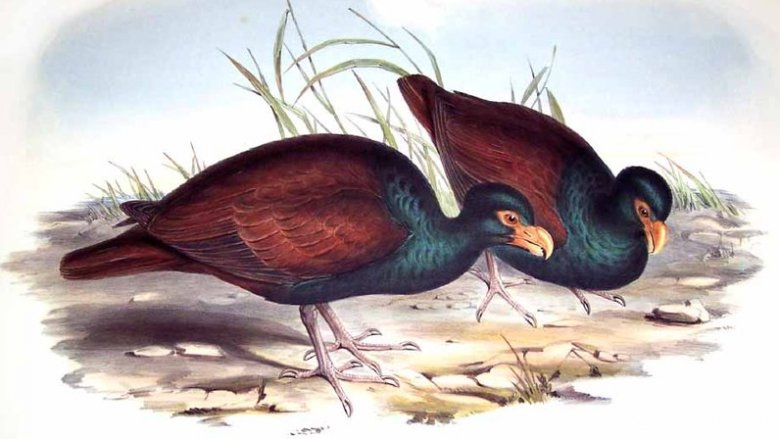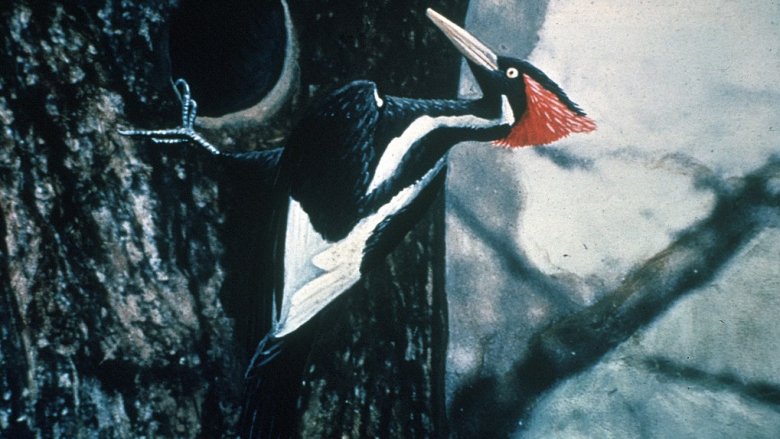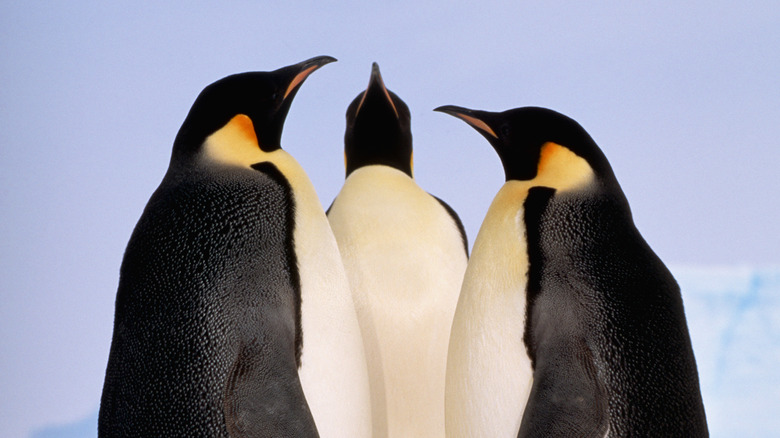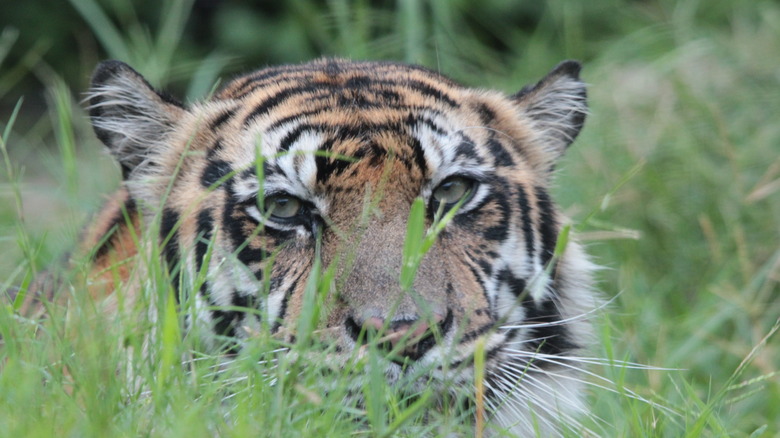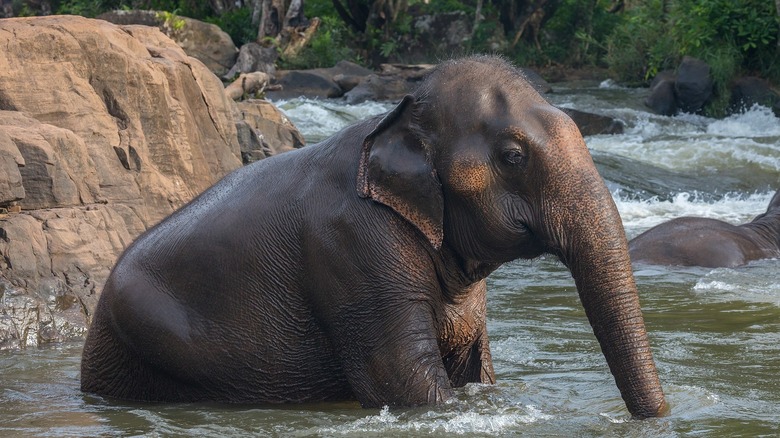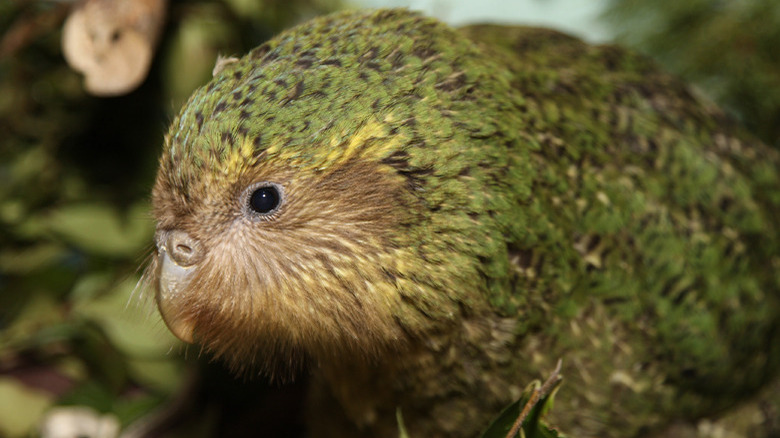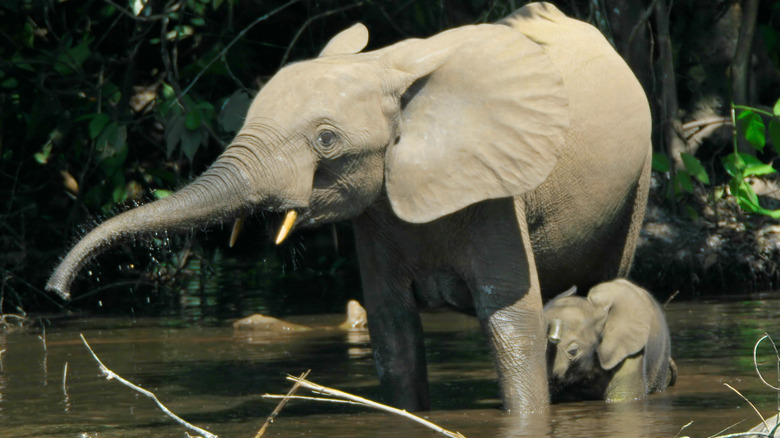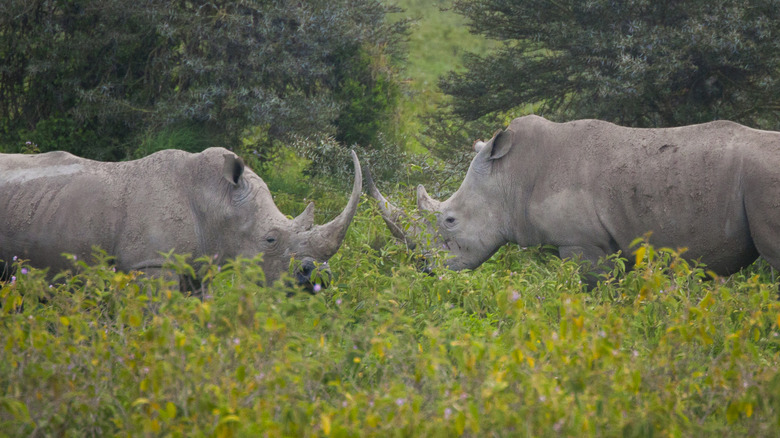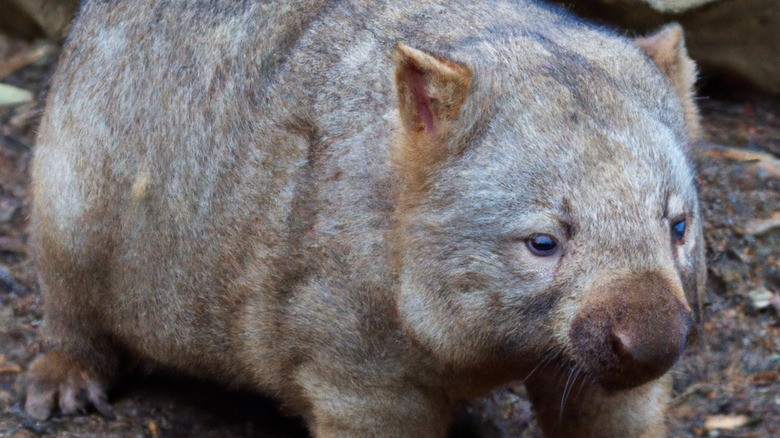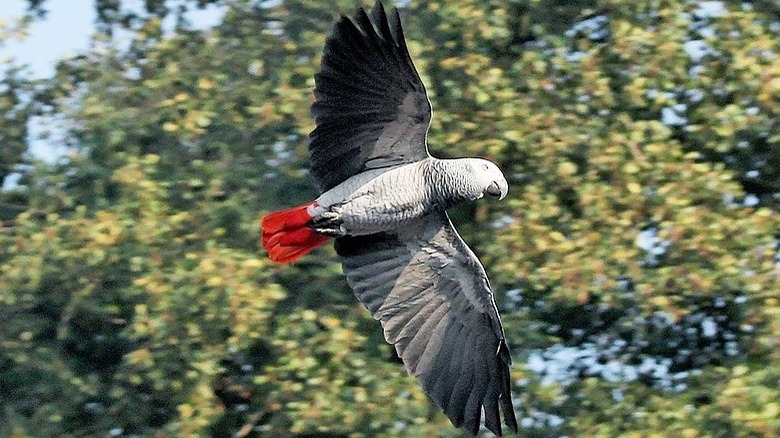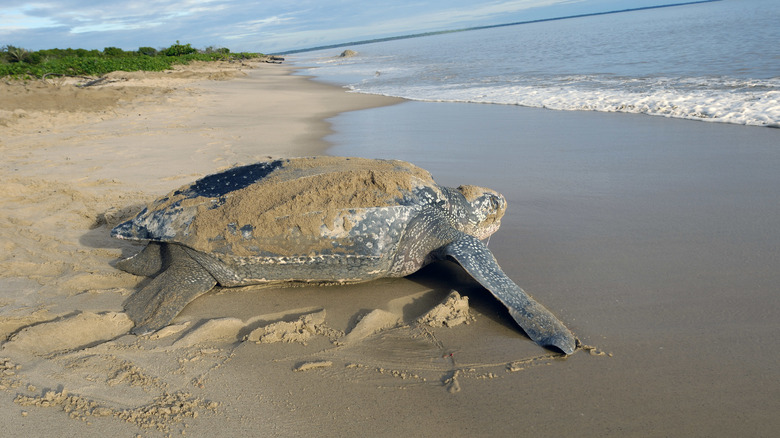Endangered Animals You Didn't Know Were In Crisis
It is believed that there have been five mass extinctions throughout the history of planet Earth, during which a massive amount of species were wiped out. And while animal populations do die out naturally, species are now going extinct at a shocking rate. Scientists now estimate that the extinction rate is 1000-10000 times higher than it would usually be, and point the finger squarely at humans, going so far as to say that we are now living through a sixth mass extinction. The kinds of human activity that pose a threat to animals around the globe vary, but the primary causes are land development, deforestation, and the destruction of natural habitats to make way for agriculture, as well as the climate crisis. More than 16,000 species of animals are currently considered endangered, and according to the IUCN, over 9,000 are considered critically endangered — meaning extinction is imminent.
Here are just a few of the animals currently facing extinction, many of them familiar. Without radical intervention to slow the climate crisis, conserve vital natural habitats, and protect endangered species, we may soon see a massive percentage of the animals that share our planet die out completely.
Amur leopard
Humans love big cats — we can imagine hanging out with them in our houses and watching them destroy furniture while they chase a laser dot all over the living room. Yeah, it would be super fun to have a big cat as a family pet, except for the part where they are prone to the occasional eating of the dog and smaller family members.
Even so, we love them and wish the best for them, and yet many of them are critically endangered because, as a species, we've done a pretty terrible job at protecting the prey animals they depend on and the habitat they're adapted to living in.
The most endangered of the big cats is one you might not have heard of — it's the Amur leopard, which lives in the Amur Heilong Landscape along the far eastern border of Russia and into neighboring China. According to the World Wildlife Federation (WWF), the Amur leopard is a cold-weather cat, with a coat that can grow nearly three inches long in the winter. Because of that gorgeous fur coat, they're a popular target for hunters, but that's not the only reason why they're critically endangered. The roe and sika deer they depend on for food are also hunted by humans, and the cats are losing habitat, too. Happily, conservation efforts have helped to increase their numbers, but there's still a long way to go — less than 100 individuals now exist in the wild.
Cross River gorilla
The Cross River gorilla is indigenous to a very small, 3,000 square mile region in Cameroon and Nigeria's rainforests, making it both the westernmost and northernmost species of gorilla. According to the World Wildlife Federation, these particular primates are wary of humans, and because their home is remote and rugged, it's tough to count individual animals. Instead, scientists use strategies like counting nests and estimating the size of group ranges, and their conclusions are pretty dire: As of 2019, scientists think there are only 200 to 300 Cross River gorillas remaining in the wild.
The Cross River gorilla looks like the western lowland gorilla, but its head and teeth are subtly different, and it's got a different diet and culture. Unfortunately, the species' range has been transformed for agriculture and pasture, and there's been a lot of poaching, because there's a market for Cross River gorilla bushmeat in Nigeria. The gorilla's range has also been fragmented, which means less opportunity for groups to mix with other gene pools, and that's bad for the health of the species overall.
It was about to get even worse, until activists persuaded the Nigerian government to change the route of the six-lane, 162-mile long highway it was planning to build right through the Cross River National Park. The only hope for this reclusive species' survival is for Cameroon and Nigeria's governments to create protections for their habitat.
Saola
It's hard to imagine that there are any large species of mammal that science has yet to discover, but in 1992, a team consisting of World Wildlife Federation researchers and Vietnam forest control agents obtained a skull from a local hunter that looked nothing like anything they'd ever seen. That was how the saola — a forest-dwelling ungulate that lives in the Annamite mountains along the border of Vietnam and Laos — became known to modern science. The saola looks like an antelope but may be a primitive bovine, has two long horns and white stripes on its face, and is said to be one of the most elusive animals in the world; so elusive, in fact, that it's been nicknamed "the Asian unicorn."
Shortly after it was "discovered," a pair of saola were captured, but both died within a few months. Then in 1998, researchers got a photo of one on a trail cam. The next year, they got another photo. And then 15 years passed before anyone saw another saola.
Saola are vulnerable to poaching, though many of the snares that trap them are set for other species. Still, their numbers are estimated at less than 750 individuals, maybe even less than 100. Many scientists believe the only hope for this species is a captive breeding program, which is a tall order considering that no biologist has ever actually seen one of these things in the wild.
[Featured image by Silviculture via Wikimedia Commons | Cropped and scaled | CC BY-SA 3.0]
Vaquita
The vaquita is a porpoise, not a dolphin, and there are some major differences between the two. Porpoises are chubbier than dolphins, they have triangular dorsal fins (versus the dolphin's hooked dorsal fin), and they lack the distinctive dolphin beak. But ultimately, they are all cetaceans, and at roughly 100 pounds, the vaquita is the smallest of them all.
Vaquitas were driven to the edge of extinction by commercial fishing. They aren't specifically targeted for harvest, but they get caught up in the gill nets used to catch the totoaba, a huge fish prized for, of all things, its swim bladder — one totoaba swim bladder is worth a tidy sum in China's black market, where it's considered a health food. For a while, scientists entertained the notion of a captive breeding program for the vaquita, but there are now too few of them remaining to make that possible. In 2012, there were just 200 left in the wild. By 2014, that number was down to 100, and only 25 of which were females of breeding age. In 2018, scientists were able to locate just 22 individuals.
Northern white rhino
One particular rhino species qualifies as one of the most endangered species on earth. The northern white rhino, in fact, is considered "functionally extinct," because the last male member of the species died in 2018, and his two surviving offspring — a mother-daughter pair — aren't healthy enough to reproduce.
That seems like an evolutionary dead end, but there might actually be hope. According to Smithsonian, there are scientists on four continents working on the northern white rhino problem, and they think they may be able to bring the species back from the brink by harvesting eggs from the two remaining females or by working with pluripotent stem cells, which can be generated from other adult cells and then used to make functioning egg cells. The eggs can then be implanted in a surrogate such as a southern white rhino or — get this — a horse. And the advantage of using stem cells is you can generate eggs with a broad genetic variety, which solves the shallow gene pool problem you get when trying to revitalize a very small population of animals. So it may seem bleak, but thanks to science, the northern white rhino still has a shot.
Pangolin
If you ever admired a roly-poly as a kid, you'd almost certainly love the pangolin, because the pangolin is basically just a giant roly-poly — though it has also been described as an artichoke with legs. Pangolins are mammals, but they're covered with large scales, so people sometimes mistake them for reptiles. When threatened, pangolins will roll up into a ball just like roly-polys, which makes them both adorable and terrifying because they can also use their scales like knives, which means you don't really want to try petting one.
Unfortunately for the pangolin, it lives in places where superstition is still a big part of the culture, and there's a lot of pangolin-related superstition. The pangolin is considered the most trafficked mammal in the world, largely because people believe their scales have a myriad of magical properties: When mixed with bark, they can ward off evil, for example, or when burned, they can improve the health of your cattle. And the scales are popular in China, too, where they're thought to cure diseases like cancer and asthma. And most disgustingly of all, the meat is considered a delicacy — according to the International Union for Conservation of Nature, it's often served at banquets in Asia as a "luxury food."
There are eight species of pangolin – of these, the Chinese pangolin is probably the most critically endangered. No one seems sure what their numbers are, but researchers think their population has declined by more than 50 percent since the 1970s, according to the BBC.
Florida panther
America has its fair share of critically endangered animals. In Florida, there are two types of native cat: the bobcat and the Florida panther. The latter is the one we're most concerned about, though, because the National Park Services says that over the years, it's lost more than 95 percent of its original range, which once stretched all the way from Florida, northwest through Louisiana, and most of Arkansas. Today, Florida panthers are confined to the southwest tip of Florida, and probably fewer than 100 remain.
The reasons for the decline of the Florida panther are complex, but can mostly be traced back to the 1800s, when hunters were paid a bounty in exchange for killing them. Then, between 1850 and 1919, huge swaths of land were cleared for lumber and agriculture, both of which decimated the panther's habitat as well as reducing the numbers of white-tailed deer — the panther's primary food source — from around 13 million to less than 1 million. And their limited numbers also put them at risk for genetic disorders. Conservationists have helped mitigate the problem by introducing small numbers of other puma types into the population — this sort of genetic exchange would have occurred naturally anyway, so it's thought to be a valid and inexpensive way to increase numbers without the risk of genetic abnormalities.
Northern sportive lemur
Everyone knows lemurs like to move it, move it. Okay, maybe you only know that if your kids played "Madagascar" on loop in the back of the minivan for like two years straight. Anyway, real lemurs mostly just stick to the trees, though one of them, called the northern sportive lemur, also has the adorable habit of striking a boxer's pose when threatened. And, it's super tiny and has huge, amber eyes, so what's not to love?
Sadly, biologists think there may be only 19 of these creatures left in the wild, which is a crazily rapid decline when you consider there were something like 10,000 to 100,000 of them in the wild as recently as 1999. So what happened? Well, according to Forcechange.com, the sportive lemur's range, which once stretched from the Amber Mountain National Park in northern Madagascar to the Mahavavy River, is mostly unprotected land, and it's all been heavily encroached by humans for things like charcoal production. As far as biologists can tell, the only remaining sportive lemurs live on a piece of land about 25 percent the size of New York City's Central Park.
The northern sportive lemur isn't the only one of Madagascar's many lemur species that's in trouble, though. More than 90 percent of the world's lemurs—all of which are found only in Madagascar—are on the brink of extinction, so conservation efforts need to focus on a lot more than just one particularly adorable type.
Mexican wolf
One victim of the human war against large predators is the Mexican wolf, a subspecies of gray wolf that lives in the southern United States and Mexico. The Mexican wolf was a victim of government bounty programs and extermination efforts by private landowners, and by 1998, there were just seven Mexican wolves left in the wild. Today, things are looking up — a 2018 survey found 131 individuals in Arizona and New Mexico, and there are some in Mexico as well. Of course, border walls don't just keep out people — biologists are concerned that a wall will keep the Mexican population from exchanging genes with the American one, and we already know how problematic a shallow gene pool can be for the health of a species.
Fortunately, Cronkite News says there are also several captive breeding programs, which means there is a healthy population of genetically unrelated wolves that could theoretically be returned to the wild to add new genes to the small population of wild wolves. So, this species may not have the numbers, but we can at least be optimistic about its potential for recovery.
Tooth-billed pigeon
The dodo bird is dead and gone, and no matter how much we would really like to use some kind of "Jurassic Park" magical DNA recovery technique to bring it back, it's probably not going to happen. Because let's face it, if it were possible to resurrect extinct animals, we'd have mammoths, velociraptors, dire wolves, and saber tooth tigers before we'd have any of those dumb, dumpy, weird-looking turkey things that got picked off like clay pigeons back in the 1500s and 1600s.
Still, almost everyone knows the story of the dodo bird, but most people don't know that the dodo bird has a cousin. And what's more, the dodo bird's cousin is about to go the same way as the dodo bird did.
According to Edge of Existence, the tooth-billed pigeon is one of the dodo bird's closest living relatives. It hangs out in forests on the island of Samoa, but like a lot of the world's critically endangered animals, not much of its habitat remains. Large parts of Samoa's forestland were cleared away and replaced with crops, and what's left has been encroached on by invasive trees and toppled by cyclones. It's hard to know for sure how many tooth-billed pigeons remain in the wild because they are reclusive, which means they may still live in small, remote pockets of the country. But scientists think their numbers are probably down to less than 250.
Ivory-billed woodpecker
Like the dodo bird, the ivory-billed woodpecker is one of those sad stories of species extinction that serves as a cautionary tale about the unnecessary cruelty and callousness of the world's human overlords. But what you probably didn't realize is that the ivory-billed woodpecker's story might actually be one of near-extinction, rather than certain-extinction. Sure, it's true that there has been no confirmed sighting of the ivory-billed woodpecker since 1944 (unless you count the report published in 2005, which was loudly criticized by skeptics as "inconclusive," per National Geographic), but its habitat is deep within the forested swamps of Florida and Louisiana, which means there are plenty of places for isolated pockets of the species to hide.
The ivory-billed woodpecker is kind of a goofy-looking thing — it's the largest of its kind, and it's brightly colored like the woodpeckers we're used to seeing, but it's also long and lean. As you can imagine, spotting an ivory-billed woodpecker these days would be like the holy grail of birdwatching, and Audubon says a birder named Michael Collins might have got footage of the woodpeckers in 2006, 2007, and 2008. But the videos are blurry and inconclusive, so it's still not considered proof.
[Featured image by Jerry A. Payne, USDA-ARS via Wikimedia Commons | Cropped and scaled | CC BY-SA 3.0]
Emperor penguin
Standing almost 4 feet tall and weighing up to 88 lbs, the emperor penguin is the largest species of penguin. These feathery, flightless giants are currently considered "near threatened," but an August 2023 study published in Communications Earth & Environment indicates that they may soon be endangered. It is predicted that without dramatic action, this incredible species may be destined for extinction.
Emperor penguins have evolved to live on the frigid Antarctic ice, and in spring of 2022, there was a devastating loss of sea ice. It is on this sea ice that emperor penguin eggs hatch and chicks are raised, and if the ice breaks and melts under them, the chicks are killed. The climate-change-driven loss of sea ice caused serious problems for 30% of all emperor penguin colonies, and meant that in 16 of these colonies, there were no new penguin chicks at all. As described by the study's lead author, Peter Fretwell, in an interview with USA Today, this is the worst season for emperor penguins that scientists have ever recorded.
Orangutan
Orangutans are startlingly human. Not only are they genetically among our closest relatives, they socialize and have complex social relationships like humans do, and are able to make their own tools, like utensils and umbrellas. As similar as humans are to orangutans, we are also the biggest threat to their survival, and they are currently in crisis.
In the past, orangutans lived throughout Southeast Asia, but today they are only found in Borneo and Sumatra. These last safe havens are also in peril because their rainforests are being illegally burned to make way for palm oil farms. In addition to destroying their home, these fires can also kill orangutans trapped in the burning trees. On top of this, the orangutans who are displaced often find themselves in human communities trying to survive. There, these intelligent and sensitive creatures can be kidnapped or killed by poachers looking to make money off them as pets or trophies.
There are staggeringly low levels of orangutans remaining in the wild, and without serious change, they may vanish from our planet completely. Some organizations are desperately trying to save this species, such as Orangutan Outreach, which, in addition to protecting wild orangutans, rescues and prepares orphaned infants for a life in the jungle. Others, like the Borneo Nature Foundation, work to preserve the few places on the planet where orangutans can still survive.
Tiger
In the last decade, the wild tiger population has plummeted, accelerating a decline over the last hundred years, where the population of these incredible cats — some of whom can weigh over 600 pounds — has plummeted from 100,000 across all of Asia to less than 4,000 in a few select areas. Their habitat has been reduced by more than 90%, and in the few places that they still survive, they are often in competition with humans for space and food. Tigers may be captured or killed when they hunt livestock, but horrifically, the majority of tigers killed by humans are poached to sell their body parts on the black market. Some types of tigers are more at risk than others: The Sunda tiger is among the most endangered animals on the planet, with less than 400 individual animals surviving in the wild.
Since the year 2000, around 110 tigers have been reported as having been captured and killed for their bones, fur, and other body parts each year. As noted by WWF, it is likely that the true number is actually far higher, as the majority of tigers killed are likely never reported. Conservationists are working towards preserving their remaining habitats, closing loopholes that allow tiger parts to be traded, and protecting the few tigers that still live in the wild before they are driven to extinction.
[Image by Nyonyofoto via Wikimedia Commons | Cropped and scaled | CC BY-SA 4.0]
Asian elephant
Asian elephants are known as ecosystem engineers – creatures that shape their environments just by living in them. The footprints they leave in the soil become pools, they create grasslands by pulling down trees — and then plant new ones by defecating the seeds they eat. Everywhere they go, they change the world around them, creating new habitats and preparing the way for an entire ecosystem to thrive: The loss of the Asian elephants would mean a crisis for countless species. Tragically, over the last three generations the number of Asian elephants has dropped by more than half due to deforestation and habitat loss, and many of the survivors are part of a horrifically cruel tourism industry.
In Thailand, it's believed that there are between 1,000 and 3,000 elephants remaining in the wild. The tourist industry, which separates the highly emotional and social elephants from their families, keeps them in chains, and forces them to perform for humans, giving rides which, despite their massive size, can injure their spines.
Organizations like Save Elephant Foundation rescue and rehabilitate elephants that have suffered in captivity, often relocating them to ethical sanctuaries like the famous Elephant Nature Park in Thailand. They also work to protect the few wild Asian elephants that remain, so that the elephants can shape and preserve the wild places they call home.
[Image by Basile Morin via Wikimedia Commons | Cropped and scaled | CC BY-SA 4.0]
Kakapo
This round, green, flightless parrot is a beloved national treasure of New Zealand, but it is also among the most critically endangered creatures in the world. Each kākāpō is carefully monitored to ensure the survival of the species, and through the efforts of dedicated conservationists, the species is still alive, but as of 2023, there are only 247 individual kākāpōs in the world. While this number may seem incredibly low, in 1995, there were only 51.
These incredible birds once thrived on their island home thanks to their green plumage, which camouflaged them from flying predators. However, with the arrival of humans in the 1300s, these plump ground-dwelling birds were extremely vulnerable to hunters and dogs, and rats often destroyed their nests.
Today, each kākāpō, which can live to be 90 years old, is tagged so that they can be monitored and protected. During breeding season, their nests are under nonstop surveillance to ensure their success, and if a mother kākāpō seems to be struggling, some or all of the chicks are moved to another mother's nest. Sometimes, conservationists will even incubate and raise chicks themselves to give each one the best chance at surviving, to preserve the species for another generation.
[Image by Department of Conservation via Wikimedia Commons | Cropped and scaled | CC BY-SA 2.0]
African forest elephant
When people think of African elephants, they might typically imagine enormous animals with large, flapping ears walking across the savanna — but there is another, less-known kind of African elephant. The African forest elephant is smaller than their savanna cousins, though they still stand up to 10 feet tall and weigh 2-5 tons. They have distinctive light yellow eyes, are rarely seen, and, as implied by their name, live deep in the tropical jungles of Gabon and the Republic of Congo. Like other elephants, they have a significant impact on the environment around them, shaping the forests by eating fruits, carrying the seeds inside them, and releasing them as waste miles away. Tragically, these captivating creatures are considered critically endangered, and their numbers are only decreasing.
It is believed that between 2002 and 2011, their population decreased by more than 60%, leaving around 415,000 in total — in regions that used to be home to millions of elephants. African forest elephants are losing their forest homes to human development and climate change, but the main threat to the species is poaching: Their tusks are valuable, leading people to kill them for ivory. Conservationists near the largest populations of African forest elephants have been successful in creating a few areas of protected habitats, with anti-poaching units to keep the animals that live there safe.
[Image by Thomas Breuer via Wikimedia Commons | Cropped and scaled | CC BY-SA 2.5]
Black and Javan rhino
Black rhinos may not be as large as their heavier cousin, the white rhino, but they can still weigh almost 3,000 pounds. It may be difficult to think of these massive horned beasts as vulnerable, but between 1960 and 1995, their population was decimated, and they are now critically endangered. As noted by WWF, 98% of all black rhinos were killed over this period, primarily by poachers looking to cut off and sell their horns, leaving a mere 2,500 individuals living in the wild. Since then, intensive conservation efforts have worked to save this beautiful animal from extinction, and today, it is believed that more than 6,000 black rhinos live in the wild. However, the threat of poaching is still a constant threat.
The most endangered type of rhinoceros, however, is the Javan rhino. In total, it is believed that there are less than 80 left on the planet, and they all live in Ujung Kulon National Park, located in Java, Indonesia. Here, the Javan rhinos in the park are protected by dedicated units that patrol the park to ensure the rare inhabitants are safe from poachers. In 2023, the park celebrated the birth of two more Javan rhinos.
Northern hairy-nosed wombat
The northern hairy-nosed wombat is a beloved symbol of South Australia, and it's easy to see why. These fascinating animals live in deep warrens, dug by their ancestors as much as a century ago, carry their children in pouches like a kangaroo, and are able to hold their own in fights against canine predators. However, they are also one of the most endangered animals in the world, with only around 315 left in the world as of 2021.
In the 19th century, large portions of their territory were destroyed to make way for farmland. There, they lost out to invasive species like rabbits and livestock, and were shot in massive numbers by humans — at one time, only 35 of these wombats were believed to remain. Their numbers only started to improve after 2001, thanks to conservation measures, which included creating a designated reserve for the northern hairy-nosed wombat where they could live and breed safely.
African grey parrot
Parrots are famous for being able to talk, and none are as good at copying human language as the African grey parrot. This large and remarkable bird is believed to be as intelligent as a five-year-old human child. Unfortunately, its brilliance makes it very appealing to humans, and a desire to keep these parrots as pets has led to a black market trade that puts their survival in the wild at risk. In combination with the destruction of their habitats for development, the pet trade has caused the population of wild African grey parrots in some areas, like Ghana, to drop by 99% since the early 1990s.
Although they are endangered, smugglers frequently target flocks of African grey parrots, capturing them by the dozens, and selling them illegally around the world as pets. Organizations like the Zoological Society of London work with local officials to try to prevent poaching, while rehabilitating the parrots seized in raids until they can be returned to their natural habitats. However, the desire from people around the world to keep these intelligent animals as pets continues, creating the demand that pushes smugglers to capture the surviving birds and take them from their flocks.
[Image by Robert01 via Wikimedia Commons | Cropped and scaled | CC BY-SA 3.0 Germany]
Leatherback turtle
Leatherback turtles have been swimming the planet's oceans for more than 100 million years, are able to travel more than 10,000 miles a year, and can dive almost 4,000 feet underwater. The species as a whole is only classified as vulnerable rather than endangered, but some subpopulations, such as those that live in the Pacific Ocean, are critically endangered and facing extinction.
In the Pacific, leatherback turtle populations have decreased by more than 90%, driven by human encroachment into and destruction of the beaches where turtles have laid their eggs for generations. A combination of factors have caused these locations to become unsuitable for turtle nests, including rising ocean levels due to climate change, human development on beaches, and bright lights overnight preventing baby turtles from reaching the ocean. As recently as the early 1950s, there were as many as 10,000 leatherback turtle nests on Malaysian beaches yearly. Since the early 2000s, there have been only one or two nests every year.
In the past, some leatherback turtles and their eggs were hunted by humans for food. While this is illegal in many places today, turtles are often still killed accidentally by humans harvesting other sea creatures. Pollution and trash in the oceans have also done terrible damage to leatherback turtles, who may accidentally eat or become trapped in human garbage floating in the water.
